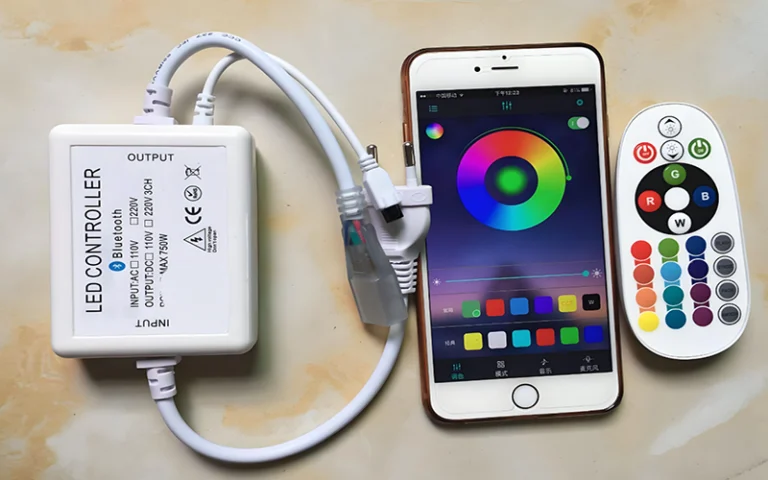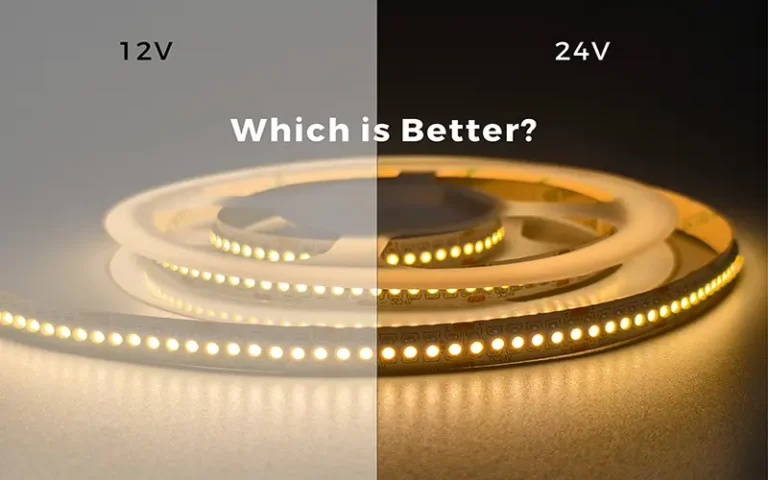How to Choose LED Power Supply for LED Light Strips?
LED light strips run on low voltage DC 12V and 24V. So an LED power supply is required to convert the 120V/240V AC (depending on your location) into a voltage signal. That the LED strip can use. Since LED light strip slighting solutions come in different sizes. The LED power supply you need will depend on the length and type of LED light strips used in your project.
There are many different factors to consider when choosing an LED power supply for LED strip lights. This article will explore these factors, what an LED power supply is, and what it is used for. And help you choose the right LED power supply for your LED strip!
What is an LED Power Supply?
An LED power supply is a lighting device, also known as an LED driver or LED transformer. That converts power input from a mains power supply (such as 120V or 240V AC) into a lower voltage direct current (DC) signal suitable for operating LEDs.
What is the LED power supply used for?
LED power supplies play a vital role in ensuring safety, efficiency. And reliable operation of LED lighting systems by providing the proper voltage and power regulation required to effectively drive LED strips.

Voltage conversion
LED power supplies convert the high-voltage AC power from the mains supply into a low-voltage DC output suitable for powering LEDs. Common output voltages of LED power supplies include 12V DC, 24V DC, etc.
Protection
LED power supplies typically include protection features such as overvoltage protection, overcurrent protection, short circuit protection. And thermal protection to protect the LEDs. And the power supply itself from damage caused by electrical faults or environmental conditions.
Stability
The LED power supply stabilizes the output voltage to ensure that the connected LED lights continue to operate reliably.
Efficiency
High-quality LED power supplies are designed to operate at high efficiency, minimizing energy loss during conversion and reducing heat generation.
What Types of LED Power Supplies are There?
LED power supplies come in many types and configurations to suit different applications, voltage requirements, and environmental conditions. Here are some common LED power supply types:
Constant voltage LED power supply
Constant voltage LED power supplies provide a fixed voltage output. Such as 12V DC or 24V DC, to connected LED lighting fixtures. It is commonly used in LED strips, LED modules, and other low-voltage LED applications.
Constant current LED driver
Constant current LED drivers provide a stable current output to an LED lighting fixture. While adjusting the voltage as needed to maintain the desired current level.
Dimmable LED driver
Dimmable LED drivers allow users to adjust the brightness of connected LED lights. Which uses a dimmer switch, remote control, or smart home automation system.
Waterproof LED power supply
The waterproof LED power supply has a sealed casing and a special coating. The IP rating is IP65 or above, which can withstand moisture, rain, and outdoor environments.
Triac Dimmable LED Driver
Triac dimmable LED drivers are specifically designed for use with Triac dimmer switches. Commonly used in residential and commercial lighting control systems.
DALI LED driver
DALI (Digital Addressable Lighting Interface) LED drivers are compatible with DALI lighting control systems. Allowing centralized control and programming of LED lighting fixtures.
How to Choose the Right LED Power Supply?
When choosing a suitable LED power supply for an LED light strip. It mainly depends on the parameters of the LED light strips. You need to consider the following factors to find a suitable LED power supply.
Determine LED Light Strips Voltage
When you choose or replace a power supply. It is very important to ensure that the output voltage is compatible with the LED strip voltage. The first thing to do is to confirm whether the LED light strip is constant voltage or constant current, and what the voltage is.
Most LED strips on the market run on 12V DC, with others mainly using 24V DC. So, you need to pay attention to the voltage of the LED strip in the product description or specification sheet. For example, if the LED light strip describes 12V or the PCB board describes 12V, you need to choose a 12V power supply.

Determine the Wattage of LED Light Strips
First of all, we need to understand the wattage of the LED light strips you choose. The general display data is W/m. In addition, in your project, how many meters of LED light strips do you plan to connect to one power supply? Then add the power in meters of all the LED strips to calculate the total wattage used.
To ensure you have a large enough LED power supply. Give yourself a 20% buffer for the total LED wattage you calculate. This can be easily done by multiplying the total wattage by 1.2 and then finding a power supply that fits that wattage.

Let’s take an example, the power of one meter LED strip is 10W per meter. We have 2pcs of 5 meter/reel, each reel running at about 50 watts. Simply multiplying these together shows that our system wattage should be approximately 100 watts. Now we can add 20% of the recommended buffer, giving us 100 x 1.2 = 120 watts. A 120-watt (or higher) LED power supply is sufficient for this project of LED light strips.
Confirm whether you need an LED power supply with dimming function
If the LED strip you choose is dimmable and you also want to adjust its brightness. Make sure you choose a power supply with dimming capabilities. Power supply specifications should list whether the power supply is dimmable and what type of dimmer control it uses. The two conventional dimming power supplies are as follows:
PWM dimming: Also known as pulse width modulation dimming, it can be used on all power supplies. Can be dimmed via wall-mounted or remote PWM dimmer. This is because the PWM dimmer is in series with the strip light, dimming it on the 12VDC side of the circuit.
TRIAC Dimming: This type of dimming allows the LED to be dimmed using a standard dimmer. You must make sure your power supply meets AC (TRIAC) dimming requirements by checking the specifications. These power supplies work by changing the power on the TRIAC-dimming-LED-strips side of the circuit via a TRIAC dimmer.
Power supply installation environment
When choosing a power supply, we need to pay attention to the area and environment in which it is used. Make sure the area is not too hot or too cold and that heat does not build up to a damaging degree. Power supply specifications should include safe operating temperature ranges. It’s best to operate within this range and be sure not to place the power supply in a location where it could generate heat and exceed the maximum operating temperature.
The power supply needs to be installed in a ventilated and dry system to help the LED power supply dissipate heat well. Thus, performance can always be maintained.
Waterproof rating of power supply
Each LED power supply also has an ingress protection (IP) rating. The IP rating consists of a two-digit code that indicates the size of solids and the pressure of liquids that the power supply can withstand. The first number refers to the size of solids the device can handle, while the second number refers to the amount of liquid the device can handle.
As the number increases, so does the level of protection. You need to choose a suitable waterproof power supply based on where the LED power supply is installed.
LED power supply size
When selecting a power supply for your LED project, it is important to understand where the power supply will need to be mounted. The size of the LED power supply needs to be confirmed, it must be small enough to fit in the space provided. There are various sizes and shapes of power supplies available to meet your needs.
Summarize
Hopefully, this article will help you find the right LED power supply for your LED light strips. The above has analyzed the types of LED power supplies and how to find a suitable LED power supply for LED light strips. You need to comprehensively analyze the project conditions based on your project and installation conditions to find a power supply that suits you. We are an LED light strips factory, please contact us if you have any needs.
FAQs
An LED power supply, also known as an LED driver or LED transformer, converts the AC voltage from the mains power supply into the appropriate DC voltage required to run the LED light strips. It is mainly used to convert low-voltage lighting systems such as LED light strips and modules.
Start by checking the specifications of your LED strip to determine its voltage requirements. Generally, LED light strips usually work at 12V or 24V DC. You need to choose the appropriate LED light strip voltage according to your project. Then select the voltage of the LED power supply according to the voltage of the LED light strip.
The rated power of the LED power supply mainly depends on the total power consumption of the LED light strip. You need to confirm how many meters of light strip you use with one power supply. You can calculate the total wattage by multiplying the wattage per meter of the LED light strip by the total length of the installation.
Constant voltage LED power supplies provide a fixed voltage output, while constant current LED drivers provide stable current output for LED strips. Choose the appropriate type based on the requirements of your LED strip lights.
Yes, multiple light strips can be connected to one power supply. The premise is that you need to calculate the total power of all connected LED light strips and reserve 20% space. Remember, the total wattage does not exceed the maximum output rating of the power supply.








